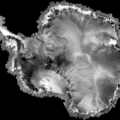
Researchers from the British Antarctic Survey (BAS) and the U.S. Geological Survey (USGS) conducting a study of Antarctic glaciers have found that over the last 50 years, 87 percent of the 244 glaciers studied have retreated, and that average retreat rates have accelerated. The study was based on aerial and satellite photographs and was published this week in the journal Science.
The researchers analyzed more than 2,000 aerial photographs dating from 1940, and over 100 satellite images from the 1960s onwards, to calculate the position of glacier fronts along the coast of the Antarctic Peninsula. These historical records reveal previously unknown patterns of change. “Fifty years ago, 62 percent of the glaciers that flowed down from the mountains to the sea we looked at were slowly growing in length, but since then this pattern has reversed. In the last 5 years the majority were actually shrinking rapidly. The retreat began at the northern, warmer tip of the Antarctic Peninsula and, broadly speaking, moved southwards as atmospheric temperatures rose. This region has shown dramatic and localized warming – around 2& #176;C in the last 50 years – but this is not the only factor causing the changes. It’s a complex picture,” said the study’s lead author, Alison Cook.
Glaciologist and co-author of the paper David Vaughan said the results of the study could help scientists understand the consequences of Antarctic temperature rise. “These glacier retreat patterns combined with dramatic ice shelf break-ups leave us in no doubt that the Antarctic Peninsula ice sheet is extremely sensitive to recent warming. What we still need to determine is whether or not the warming in this area has its roots in human-influenced global warming. Either way, continuing retreat of glaciers in this area is important because it could allow more ice to drain from further inland and contribute to sea level rise,” he said.


















Comments are closed.